MICHELLE PFEIFFER POSTED BACK IN JANUARY

Back in January, Michelle Pfeiffer posted the image above to Instagram, with the following caption:
Let’s do this, Monday.(I bought these sunglasses at a drugstore. True story. 😎)
 Hello and welcome to the unofficial Brian De Palma website. Here is the latest news: |
|---|
E-mail
Geoffsongs@aol.com
-------------
Recent Headlines
a la Mod:
Listen to
Donaggio's full score
for Domino online
De Palma/Lehman
rapport at work
in Snakes
De Palma/Lehman
next novel is Terry
De Palma developing
Catch And Kill,
"a horror movie
based on real things
that have happened
in the news"
Supercut video
of De Palma's films
edited by Carl Rodrigue
Washington Post
review of Keesey book
-------------
Exclusive Passion
Interviews:
Brian De Palma
Karoline Herfurth
Leila Rozario
------------
------------
| « | April 2022 | » | ||||
| S | M | T | W | T | F | S |
| 1 | 2 | |||||
| 3 | 4 | 5 | 6 | 7 | 8 | 9 |
| 10 | 11 | 12 | 13 | 14 | 15 | 16 |
| 17 | 18 | 19 | 20 | 21 | 22 | 23 |
| 24 | 25 | 26 | 27 | 28 | 29 | 30 |
De Palma interviewed
in Paris 2002
De Palma discusses
The Black Dahlia 2006

Enthusiasms...
Alfred Hitchcock
The Master Of Suspense
Sergio Leone
and the Infield
Fly Rule
The Filmmaker Who
Came In From The Cold
Jim Emerson on
Greetings & Hi, Mom!
Scarface: Make Way
For The Bad Guy
Deborah Shelton
Official Web Site
Welcome to the
Offices of Death Records

Let’s do this, Monday.(I bought these sunglasses at a drugstore. True story. 😎)
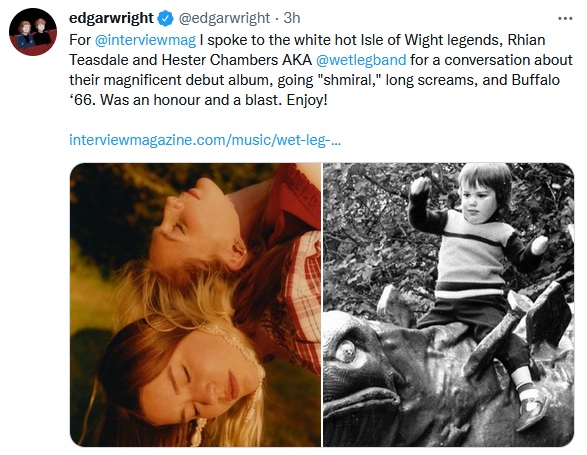
WRIGHT: So, you’ve been sitting on this amazing debut for nearly a year.TEASDALE: Yeah, we finished recording, but then we had to do all the artwork and get it mixed and mastered. It doesn’t feel like it’s been a year, it feels like we only really finished it six months ago. When you finish a film, how long until it’s released?
WRIGHT: It depends on when it’s supposed to come out. Hot Fuzz came out like a month after it was finished. It was really down to the wire. But Last Night in Soho was disrupted by the pandemic, so we shot nearly all of it in 2019 and 2020, and it came out in 2021. It’s really emotional for me to watch that film, because it feels like so much happened in the space and time of the production. So it depends on what it is, really, and whether there’s a global pandemic or not.
TEASDALE: When you watch your own stuff, are you transported to that version of you? Do you put yourself into your art and your characters?
WRIGHT: Oh, yeah. That’s what’s strange—Shaun of the Dead is a film about a zombie apocalypse, Hot Fuzz is a film about cops in Somerset, Last Night in Soho is about a Cornish fashion student coming to London with supernatural powers—and I say, “Oh, they’re all really personal.” [Laughs] People are like, “How?” But you do put yourself into them, and you’re dramatizing your own mundane experiences into something more exciting. You guys are from the Isle of Wight, and I grew up in Dorset and Somerset, so a lot of what I’ve done is the product of being bored as a teenager. Somerset a very picturesque and beautiful place, but when you’re a teenager, picturesque is not what you want—you want to get to the city. Now I’m older and I think more fondly about my bucolic childhood in the country. So, all of the things you make become like love/hate letters to the place that you’re from.
TEASDALE: Yeah, I can relate to that.
WRIGHT: I can feel those country vibes in your work as well. The album seems to have themes. One theme is that it seems like you guys get annoyed at house parties a lot.
TEASDALE: Yeah. FOMO is such a thing, isn’t it? And you’re always trying to “live your best life,” but sometimes you just need to listen to yourself, and maybe just don’t don’t go to the party. I’m not able to do that quite often.
WRIGHT: I didn’t have Instagram when I was growing up, so I was always thinking that there must be something cooler going on without me. I grew up feeling like I was never going to the cool parties, but it seems like, from your album, that you’ve been to the cool parties, and you’re not impressed.
TEASDALE: Yeah, that’s it.
WRIGHT: I think it’s a good message to tell the young people out there: don’t worry guys, you’re not missing that much.
CHAMBERS: We’ve dipped our toes in the little pool of music videos, but you are a filmmaker. We are not filmmakers, but if you had a tip for us, what would it be? Also, what’s one of your favorite movies?
WRIGHT: Well, what makes you think that you’re not filmmakers? That doesn’t make any sense, because you already have a point of view and an aesthetic. You can tell what a Wet Leg video is just from the four that you’ve released already, which is great. Why don’t you make a Wet Leg movie? Here’s the pitch: every attraction at Blackgang Chine comes to life, and only Wet Leg can stop the chaos from spreading across the rest of the world.
TEASDALE: [Gasps] The Mouth of Hell.
CHAMBERS: The Weather Wizard!
TEASDALE: The Rumpus Mansion!
CHAMBERS: There’s also a really scary Humpty-Dumpty there.
WRIGHT: Okay, I’m going to suggest a favorite film of mine. If you haven’t seen it, I can’t imagine you guys not loving it. Have you ever seen the 1974 musical Phantom of the Paradise?
TEASDALE: Phantom of the Paradise? No, I haven’t seen that.
WRIGHT: I’m going to get it to you because I cannot imagine that you wouldn’t love it. It’s like a rock musical. It’s Phantom of the Opera meets Faust, it’s got a ‘70s score written by Paul Williams, and it’s fantastic. That’s one of my favorite films that I think you guys would dig.
TEASDALE: I’ve written it down. One last question, do you have a DVD collection?
WRIGHT: I do, I can show you. Hang on, we’ll take a little walk. Buffalo ’66 is not there because I looked for it earlier. Look, here you go, this is what I was doing during the lockdown.
[Wright shows Wet Leg his substantial DVD collection]
TEASDALE & CHAMBERS: Wooowwwww!
WRIGHT: Physical media—it hasn’t gone away! Who knows when the internet will go? I’ve still got a lot of Blu Rays to organize. I can’t stop buying them— I went on a bit of a crazy Amazon kick during the lockdown. The Oxfam around the corner from my house has had a steady stream of the ones I’ve been giving away. I donate a lot of horror films to the Oxfam. I wonder about the kind of the person that goes in there and finds all these really hardcore horror films. Somebody’s going to have a wild afternoon.
TEASDALE: We love horror films.
WRIGHT: What are some of your favorite horror films?
TEASDALE: Evil Dead.
CHAMBERS: I like Death Becomes Her, I think that’s such a funny film.
WRIGHT: I saw that at Bournemouth when I was at art college. I haven’t seen it since— I don’t want to guess a lady’s age—but probably before you guys were alive.
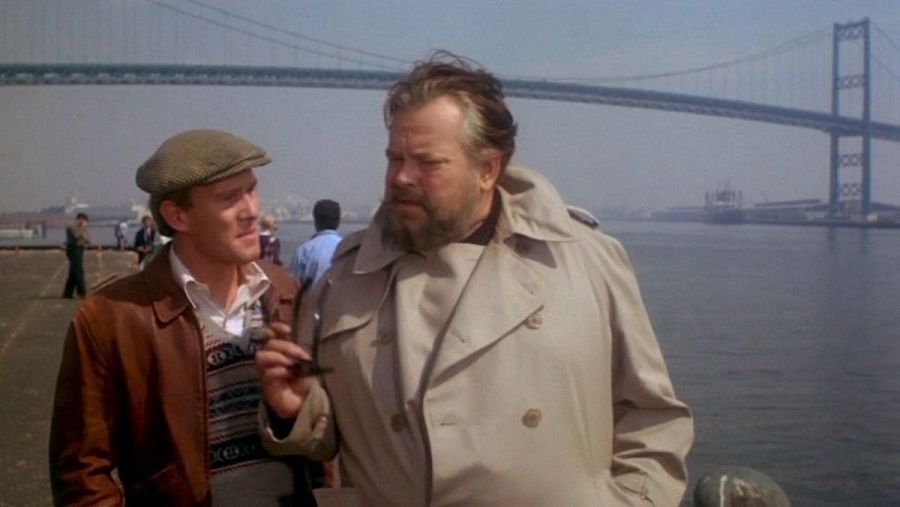
Get to Know Your Rabbit is a mess – a mishmash of creative visuals rubbing awkward elbows with dry and slapstick comedy ideas. One reason for this disjointed quality, the film’s jumps around in rhythm and moods – Warner Brothers did a major re-edit after director Brian De Palma handed in his final cut. The result is that it feels as if you are watching pieces taken from different films that have been haphazardly thrown together. Improbably, that’s also what gives this movie its eccentric, shaggy charm.Or maybe it’s because it has one hell of a cast: Tommy Smothers, Orson Welles, John Astin, Katharine Ross and, in cameo roles, Bob Einstein, Allen Garfield, and M. Emmet Walsh.
Hold on, it could be the story: Donald (Smothers), an overworked marketing analyst at a large corporation, fed up with the stress of the daily grind. He quits and enrolls in a school for tap-dancing magicians run by Mr. Delasandro (Welles). Donald’s feckless boss, Mr. Turnbull (Astin), realizing he’s helpless without Donald, hatches myriad underhanded schemes to get him back. Too late; Donald has graduated, been given his rabbit, and hopped a bus to begin “a 7-week swing through the second-rate bars and cocktail lounges in America’s heartland” as a tap-dancing magician.
His boss falls from grace but, because he was once a marketing man of merit, the guy comes up with a surefire publicity gimmick: an offer for burnt-out executives to quit their jobs, reinvent themselves as tap-dancing magicians, and “live life at the gut level!”
The film is uneven and goofy, but it features stand-alone segments that are brimming with heart. Of the actors, Smothers contributes a welcoming, natural delivery, Ross plays it slightly ditzy, Welles goes eloquently over the top in a self-deprecatory manner, and Astin comes up with a zany character who is smart, sympathetic, deceitful, ruthless and, most important, fun to watch.
De Palma is already dealing with stylistic elements that would become hallmarks in his later films: dissolves, wipe edits, split screens, and film-within-film.
Highlights include Welles joyously conjuring a cocktail from a handkerchief; a tracking shot of Smothers walking (from the viewpoint of an overhead camera) through his maze of an apartment, and every single scene featuring Astin.
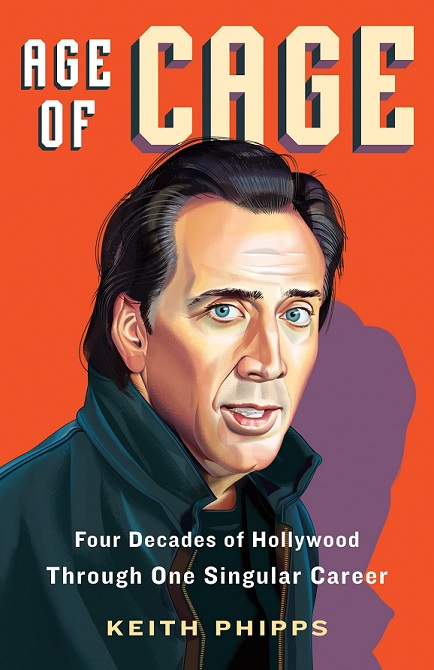
In the book itself, Phipps spends a couple of paragraphs on Brian De Palma's Snake Eyes:
In August, Snake Eyes debuted to an audience of summer moviegoers hungry for another Cage action film. Instead, they got a twisty, recursively structured thriller directed by Brian De Palma featuring some jaw-dropping moments of cinematic showmanship—including a seemingly unbroken thirteen-minute opening shot that whisks viewers through the belly and onto the floor of an Atlantic City arena playing host to a heavyweight championship bout—and a climax that doesn’t work.Working again with a master filmmaker of the generation that emerged alongside Francis Ford Coppola, Cage offers a vivid performance—one filled with the sort of manic gestures and explosive line readings that would resurface in later work—as a gleefully corrupt cop who stumbles his way toward redemption after discovering that a childhood friend (Gary Sinise) has masterminded a conspiracy. Though Snake Eyes had much to recommend it, particularly for longtime admirers of De Palma and Cage, collections of compelling elements that fail to gel into coherent movies rarely become hits. Hampered by middling reviews—in the LA Weekly, Manohla Dargis described it as “running on fumes” after its memorable opening—and bad word of mouth, it struggled at the box office.
Snake Eyes (1998) ***Sold as another Cage action film, this twisty Brian De Palma thriller confused moviegoers expecting more blood and bullets. That the film, even on its own terms, has problems didn’t help, but Cage has fun playing a cop who loves being on the take and who enjoys everything corruption brings him—until he has to face a moral reckoning.
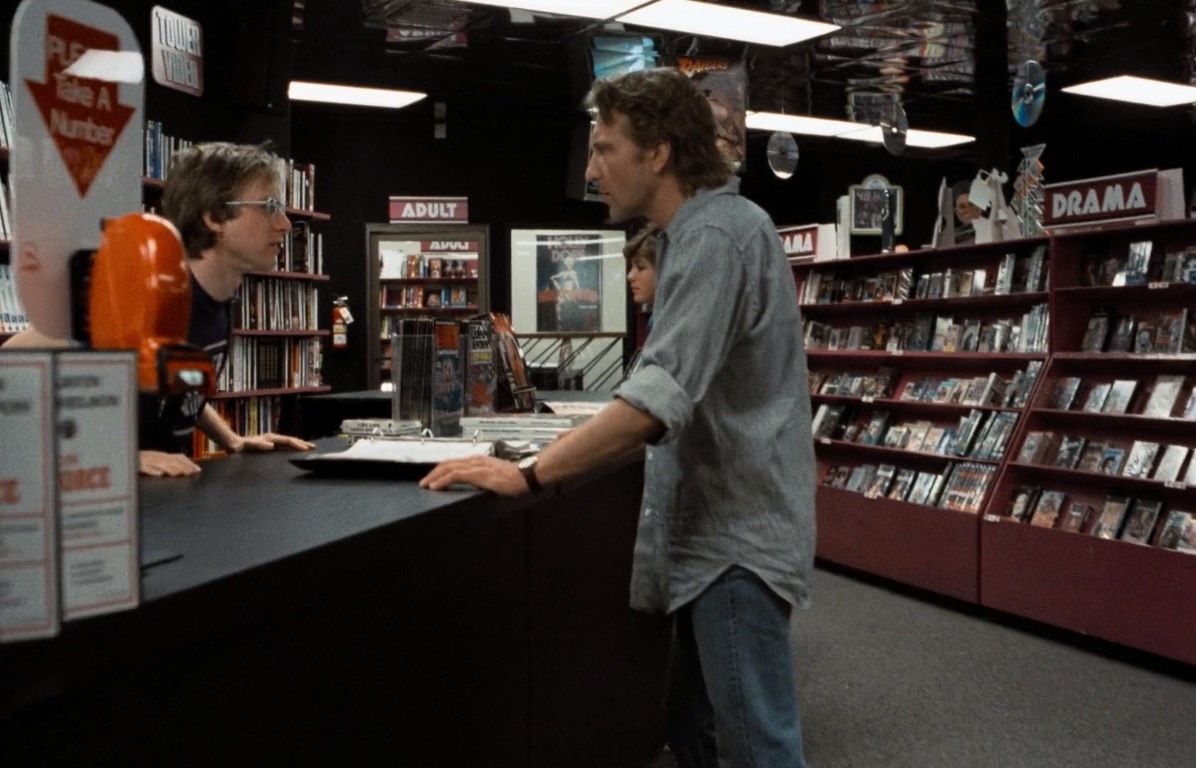
Most people would call the cops after finding out that their landlord is illegally spying on his residents’ every move, but not Sharon Stone in Sliver. Stone’s character, Carly Norris, is a buttoned-down book editor who specializes in tell-alls and unabashedly elbows someone aside at a cocktail party to get a better look at a couple having sex without the curtains drawn in a nearby building. A wolfish grin stretches across her face as one of the guests yelps, “She’s a voyeur! She can’t get enough!” No one would ever accuse the erotic thriller of being too subtle. Carly likes to watch, and so does her eventual lover, Zeke Hawkins (William Baldwin), who lives a few floors down in the Manhattan high-rise she just moved into and who, it turns out, also owns the building. Zeke, in fact, likes to watch so much that he has had all the apartments rigged with hidden cameras, the live feeds transmitting to a state-of-the-art room in the back of his bachelor pad.The first time Zeke shows Carly his surveillance chamber, she storms out in disgust. Then, unable to help herself, she comes back, settling in for a long session of spying on her oblivious neighbors, so enrapt that she forgets to eat. The ability to commune with the illicit footage in an intimate setting, flipping between channels, almost matters more than what she’s seeing. It takes hours before she figures out that Zeke has a tape of the two of them fucking, and that they can watch themselves while fooling around. Basic Instinct may have secured Stone’s place as the icy blonde queen of the erotic thriller in 1992, but it was Sliver, made a year after, that highlighted a fundamental truth about the genre — that it was as obsessed with home video as the customers who enabled it to become such a phenomenon in the 1980s and ’90s.
The erotic thriller famously brought a flurry of sex and death to the multiplex, but its existence really owes everything to home viewing — to late-night cable, down-market sequels, and direct-to-video offerings. While Blockbuster refused to carry porn, it would carry a copy of In the Cold of the Night, starring Jeff Lester, Shannon Tweed, and some off-label use of a container of decorative marbles. The internet had yet to really make its arrival, but the home theater had become commonplace, and the erotic thriller thrived in private, on Skinemax or via VHS clamshells squirreled home to be watched on suburban living room screens with the curtains drawn. So it’s fitting that the genre was just as in thrall with the idea of home viewing as its primary audience. Scopophilia and surveillance were two of its regular preoccupations, but so was the possibility of having illicit recordings on tape — as leverage for blackmail, as stroke material, or simply as something that can be kept and revisited whenever the urge strikes.
There was a novelty to that control, to not just be able to watch but to rewatch. The roots of the erotic thriller are in film noir and Hitchcock, with all the subtext said out loud. Brian De Palma’s proto-classic of the genre, Body Double, is a jubilantly debased remix of Rear Window and Vertigo with added tits, with an invertebrate Craig Wasson as struggling actor Jake Scully, who obsesses over a woman he believes may be in danger without ever being able to spring into action to save her. But Michael Powell’s 1960 shocker, Peeping Tom, about a man who films the murders he commits, feels just as essential as a forerunner. To Mark (Carl Boehm), the wretched loner of a main character, the violence itself is less significant than the celluloid record he creates, and he carries a camera with him everywhere, often surreptitiously filming. He may not have the benefit of ’90s-era technology, but like Zeke in Sliver, he secretly owns the building he lives in and gets romantically involved with one of his tenants. And like Zeke, Mark has a back room where, using a projector rather than a close-circuit television, he obsessively reviews the surreptitious footage he has shot, as though the ability to watch in private gives him more control over the world outside.
Peeping Tom may be about a character who gets off on the fear on his victims’ faces, but the erotic thriller usually aims for the more quotidian pleasures of voyeurism. Zeke zooms in to watch the oblivious Carly masturbate in the bath while believing herself to be alone. Will (Andrew Stevens), the meathead hero of Night Eyes, totes a VHS cassette of his unknowing client home to watch the moment when, while having sex with someone else, she locks eyes with the camera she doesn’t know is there. A direct-to-video release that spawned a whole gauze curtains–heavy franchise, Night Eyes is about a security guard hired by a rock star to install a system of hidden recording devices in his house in order to get fodder for his lawyer on his soon-to-be-ex-wife, Nikki (Tanya Roberts). Nikki knows that Will has been brought on to protect her, but not that he’s being paid to surveil and inform on her, and before long he’s falling in love with her by way of those tapes — his own DIY softcore rentals — while wallowing in guilt. Then he finds himself appearing on one of them after acceding to her request to enact a rape fantasy, and understands that the unfiltered truth they seemed to offer is just an illusion when the footage is used against him.
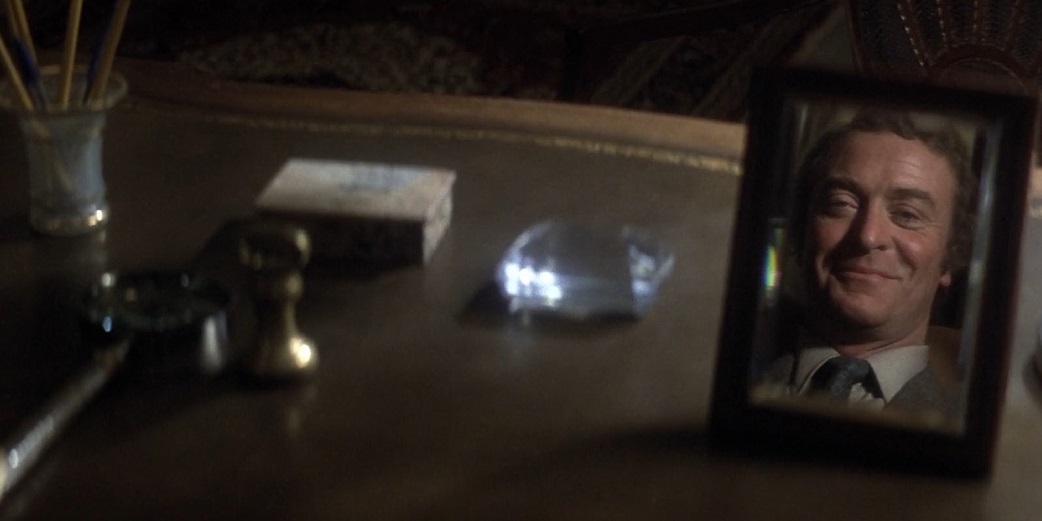
"Dressed to Kill," Brian De Palma's homage to "Psycho," casts Michael Caine in the largely thankless role of the psychiatrist whose patient is murdered and then gets drawn into the case when suspicion falls on another of his patients.This is a tricky one. On first viewing, Caine's performance in "Dressed To Kill" seems a little odd and a bit wooden. It's only once you watch the film again that you understand what he's doing. He's essentially playing a role within a role, putting on a veneer of respectability that covers a sinister secret. De Palma makes excellent use of mirrors throughout, hinting at Caine's fractured psyche. However, Caine never tips his hand. It's a performance that takes on more and more layers once you know the plot, and it's a credit to Caine that the reveal is never laughable. Be warned though, the film was released in 1980, and some of the plot twists are more than a little problematic today.
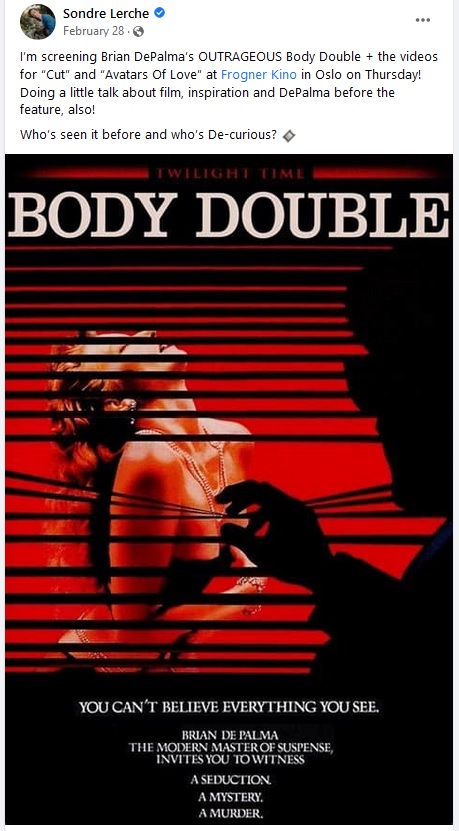
I've always been inspired by some of the films and themes of Hitchcock, also visually, in videos, of course. But recently I became interested in one of his most ardent imitators and admirers in film, Brian De Palma. The video for "Cut" is obviously inspired by De Palma's Body Double, which I just got to screen and present at an old cinema in Oslo. It's so outrageous, that movie. Stupid and clever and sleazy and sophisticated in equal measures. I like that, and it captures the theme of performative love and seduction really well, which is a major theme on Avatars Of Love.
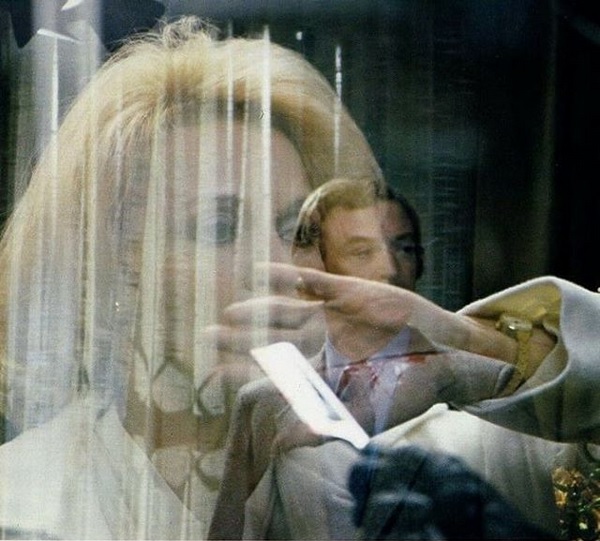
Bill Maher: What kind of movies do you hate? Like, is there a type or kind… like, for me, I will watch romantic comedies – sometimes I only want to watch a romantic comedy – but I do find them… [laughing] they try my patience. And I don’t have a lot of respect. It’s a very… I guess the old-school ones with, like, Spencer Tracy…Quentin Tarantino: Right, with Claudette Colbert, or something…
BM: Katherine Hepburn…
QT: Yeah, yeah, yeah.
BM: I mean, were they great?
QT: Well, the ones that were really funny kind of fall more into the category of screwball comedy. Which is where the romantic comedies of today came from.
BM: But it’s always a man and a woman, right?
QT: Yeah. Absolutely, yeah. And there’s a flirtation and there’s…
BM: You mean, like, It Happened One Night, and…
QT: Well, that’s a good example of one. Bringing Up Baby is a good example of one.
BM: What is, the Streisand - Ryan O’Neal movie…
QT: What’s Up, Doc? Yeah.
BM: …is a great one. Is that a remake of a…
QT: No, it’s not a remake…
BM: But it’s a tribute.
QT: Yeah, it’s kind of a paraphrase remake. All right, umm.. a special genre unto itself. It’s a paraphrase remake of the movie Bringing Up Baby.
BM: Right – Cary Grant…
QT: Yeah, Cary Grant and Katherine Hepburn.
BM: And Jimmy Stewart. Oh, no, that’s Philadelphia…
QT: That’s Philadelphia Story.
BM: Right.
QT: Okay, but the thing is like, a paraphrase remake is like the relationship that Dressed To Kill has with Psycho.
BM: Oh.
QT: Where it’s like, okay, so it’s not a remake of Psycho…
BM: I see…
QT: But…
BM: Right…
QT: There’s no way you’re watching Dressed To Kill and not thinking about Psycho.
BM: [Laughs]
QT: But the director knows that you’re watching Dressed To Kill thinking about Psycho, so he can actually hit Psycho points because you’re on the same wavelength now. And now he’s kind of remaking the movie without remaking it. Just doing his own twist on it.
BM: Right. I think it’s called a rip-off, but…
QT: No no no no, when it’s that done, when it’s done like that… okay, there’s “rip-off,” but Dressed To Kill and Psycho, no, he’s riffing.
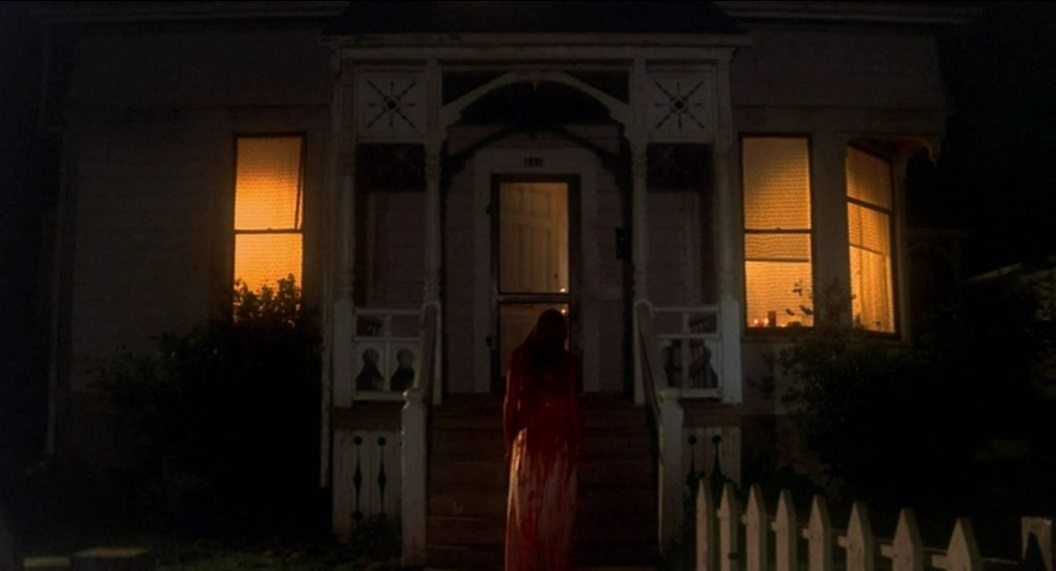
Francis Ford Coppola has four films in the top ten: The Godfather (#1), The Godfather, Part II (#4), Apocalypse Now (#6), and The Conversation (#8).
Brian De Palma's Carrie makes the list at number 50, having appeared on ten of the individual lists. Nicolas Roeg's Don't Look Now also appeared on ten individual lists, but is ranked at #49 -- it seems mostly coincidence that #49 and #50 both feature scores by Pino Donaggio (three other films surrounding these two films in the ranking also appeared on precisely ten lists). Our old friend David Greven has Carrie on his list of 15 films, as well as three other De Palma films:
David Greven (Professor/USC)THE GODFATHER, PART II
3 WOMEN
AUTUMN SONATA
DEATH IN VENICE
THE STORY OF ADELE H
CLOSE ENCOUNTERS OF THE THIRD KIND
KLUTE
TAXI DRIVER
THE EXORCIST
OBSESSION
CARRIE
THE FURY
SISTERS
IT'S ALIVE
DOG DAY AFTERNOON
Armond White (National Review)Nashville
McCabe & Mrs. Miller
Last Tango in Paris
Close Encounters of the Third Kind
The Godfather, Part II
Mean Streets
1900
Taxi Driver
MASH
Ryan’s Daughter
The Warriors
The Godfather
Sounder
The Fury
Women in Love
Tina Hassannia (Slant Magazine)Celine and Julie Go Boating
Still Life
F for Fake
Badlands
Don’t Look Now
The Brood
Solaris
California Split
Hi, Mom!
Real LifeKevin Laforest (Extra Beurre)
Aguirre, the Wrath of God
Annie Hall
Apocalypse Now
A Clockwork Orange
The Godfather
The Godfather: Part II
Halloween
Jaws
The Long Goodbye
Phantom of the Paradise
Rocky
Stalker
Suspiria
Taxi Driver
The Texas Chain Saw Massacre